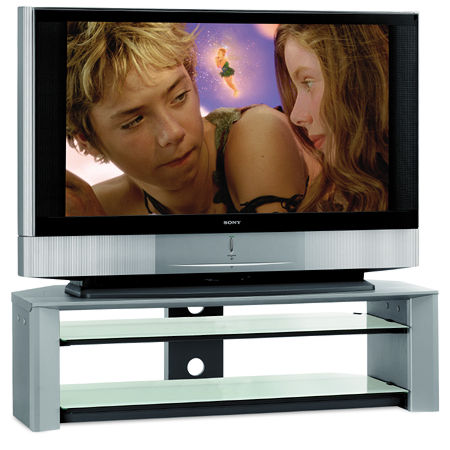Sony Grand Wega KF-50WE610

Sony has settled on LCD as its rear-projection technology of choice—at least until it can bring its new SXRD (LCoS) devices way down in price. (See the May 2004 SGHT for a full review of the Qualia 004, Sony's flagship SXRD front projector.) The 50-inch-diagonal set reviewed here is about the middle size of Sony's current rear-projection LCD offerings.
A Look Around
Far lighter and shallower than any CRT rear-projection set, if still not hang-on-the-wall flat, the KF-50WE610 has a feature lineup not much different from that of any other RPTV, whatever its technology. As an HD-ready model, its 1366x768 resolution will display full HD from any source (terrestrial, cable, satellite), provided you add a suitable outboard set-top box. The built-in tuner is strictly for standard-definition NTSC reception. (This fall, Sony plans to release a replacement for the KF-50WE610 that will add an onboard terrestrial and CableCARD–ready HD tuner. The KDF-50WE655 will sell for $3300.)
The '610's features include Twin View, in which two sources can be watched side by side and changed in relative size; and a viewer for displaying material stored in Sony's digital Memory Stick format, such as JPEG photos and MPEG1 moving images.
The video controls are not separately configurable for each input. But there are three selectable video modes—Vivid, Standard, and Pro—each of which can be modified with the user's video settings and separately assigned to the input of your choice. Advanced video options include three settings for Sony's Digital Reality Creation (DRC) deinterlacer-scaler, and a feature called Palette, which "allows you to customize the level of detail (Reality) and smoothness (Clarity)," with three memories for custom settings that can then be applied to any source. I disabled Palette and other specialized controls, such as Noise Reduction, for all my testing and viewing.
There are also a number of audio controls for the built-in sound system, plus a set of 2-channel audio outputs to route line-level sound from the TV to an external receiver or surround processor. The onboard sound is pleasant enough for watching the news, and maybe even CSI: Peoria, but no substitute for the audio system of even a modest home theater.
The remote provides full access to all important functions, and can be programmed to control a satellite/cable box and VCR/DVD, in addition to the Sony itself. Many of the buttons are small and of the same size, and only the three Function buttons light up, but I had no serious problems with it.
The Sony's projection lamp is rated for 3000 hours of use, with a replacement cost of $200. It's fan-cooled, so you'll hear some noise if you're close to the rear of the set. From a normal viewing distance in my room—6 feet or more—fan noise was not an issue.
Performance
Getting to the downside first, the KF-50WE610, in common with most LCDs I've seen, could not produce anything close to deep black. Dark, low-contrast scenes often looked grayed-out and murky—as if a heavy fog had settled around the action. Turning up the Brightness control to generate more shadow detail merely made the picture look flat and washed-out. To get the best blacks the set would give, I had to drop the brightness a little below the technically correct setting (see Taking Control in this issue). But given a choice between a slightly washed-out image or a little black crush from too low a brightness setting, I'll take the black crush. Even then, however, the Sony couldn't produce blacks anywhere near as good as you'll get with a CRT. This was only an occasional problem with most typical broadcast TV programs, which have narrow video dynamic ranges; it was much more obvious with feature-length films shot with a wide variation in lighting.
Given an image with an average or higher brightness level, the '610 quickly improved, looking crisp and clean even before calibration. After calibration, it could give most of the plasmas I've seen a strong run for their money. Yes, bad program material from my cable system—particularly when played back from a hard-disk recorder—could look grim. Garbage in, garbage out. And, as on most digital displays I've reviewed, greens were a little too bright and vivid. But the best DVDs, through a DVI or component-video connection (I used the latter for most of my viewing), were bright, sharp, and, at their best, pleasingly 3-dimensional. Sony's onboard deinterlacing and scaling also did good jobs; I rarely found any reason to switch my Panasonic DVD-RP56 DVD player to its Faroudja-chipped progressive mode.
The best high-definition programming—at least on those average-to-brightly-lit scenes—could look striking on the Sony. Not all HD is created equal, and the resolution of the '610 could easily distinguish between the great and the not-so-great. But when a pristine HD program came along, it was hard to look
away from the screen. Discovery HD, at least as received over my Charter Communications cable system's Scientific Atlanta receiver, provides consistently exceptional images. A broadcast of Trading Spaces in HD even made it thrilling to watch people schlep furniture around and watch paint dry.
Conclusion
Check carefully to make sure that those grayed-out blacks are not a problem for you. If they are, you're a good candidate for a DLP—or, even better, a CRT display. If they aren't, the Sony Grand Wega KF-50WE610 can, at its best, produce a compelling, hard-to-resist picture.
























































